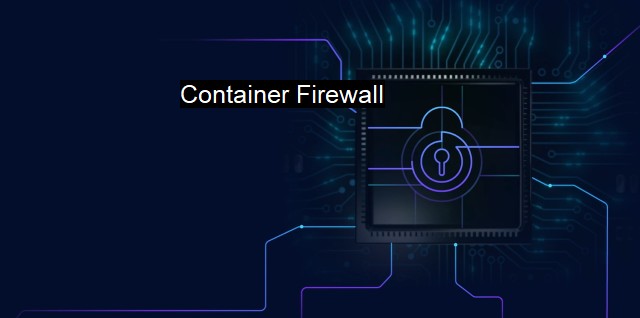What is Container Firewall?
Securing Your Digital Space: Exploring the Benefits and Functions of Container Firewall in Cybersecurity and Antivirus Defense
A container firewall is a cybersecurity solution designed to protect application containers and keep your systems safe from malicious activity. It uses access controls, security policies, threat detection, and other tools similar to traditional firewalls, albeit in a more specialized manner to accommodate unique container properties. Container technology allows developers to package software in a format that can run in any environment, be it on a desktop or a remote server. With the increasing dependence on this technology in software development circles, container cybersecurity has evolved in parallel, thus leading to the conception of container firewalls.In order to explain the role of a container firewall, we might need to look at what containers are. Containers offer a practical and efficient way to encapsulate and isolate applications while sharing the host system's OS. This reduces the container's footprint and leads to fewer system demands compared to traditional virtual machines (VMs), seriously minimizing system load when running multiple containers simultaneously. Associated libraries and binaries are kept in the actual containers, leading to smoother software performance as all necessary resources are available to ensure consistent operation.
Containment improves efficiency but also introduces extra cybersecurity risks, necessitating the container firewall. Container firewalls can be conceptualized as more elaborate versions of traditional firewalls. Unlike classic firewalls that regulate traffic from a single endpoint to another, container firewalls oversee communications between various containers on the same host or across multiple hosts.
Now, several attractive traits most container firewalls exhibit include enhancing network visibility, viewpoint control, and active security; an inactive container firewall isn't beneficial. The more evolved container firewalls are characterized by discretionary access controls. Still, they grant container-based applications appropriate privilege alignments, allowing them to function while limiting entry points for cyber threats.
Regarding the bisecting functionality that underscores "container firewalling," two processes warrant explicit mention. Firstly, intruder activity is sensed and managed as soon as it infiltrates the network. This process collectively identifies suspicious traffic patterns indicative of an ongoing cyber-attack and takes immediate measures to prevent irreversible damage. Secondly, a protective shield safeguards resources to fend off adverse exploitation- one often implemented by scanning container images and establishing best practice container policies during both build and runtime.
Container firewalls have a direct integration into the container's primary functionality, so it's effective at shielding vulnerabilities that other traditional firewalls might struggle to protect. Advanced container firewalls can identify potential threats from dangerous software and quickly filter out these programs, rendering them inactive and keeping the system safe.
Container firewalls usually operate with other integral container security tools, encompassing automated configurations and threat management solutions. These tools enhance container firewalls' overall function, equally contributing to a safe operational environment devoid of cyber threats.
Integrating a container firewall into your security system confers viable defense enhancements that fortify applications within containers. Network packets are analyzed at the granular level to detect suspicious content. This technology monitors traffic data in real-time, inspects incoming and outgoing packages, enforces policies, and counters threats before any damage is done.
a container firewall functions as a critical part of an organization's cybersecurity strategy due to its targeted protection capabilities. It helps mitigate against complex cyber threats tailored specifically for container-based architectures. Therefore, choosing the right container firewall is substantial towards securing critical software applications both at rest and while they're 'in-flight'. Considering the increasing risk of data breaches and the value of today’s data and IT infrastructure, such technologies not only reduce the risk but also improve your security management's efficiency and effectiveness.

Container Firewall FAQs
What is a container firewall?
A container firewall is a security technology used to protect containerized applications from unauthorized access and malicious activities. It acts as a security barrier between the application and the network, allowing only authorized traffic to pass through.How does a container firewall work?
A container firewall works by inspecting the traffic that passes through it, based on pre-defined security policies. It can identify and block any traffic that is not authorized, and prevent malware and other cyber threats from affecting the application. The firewall can also monitor the application for any suspicious activity and alert the security team if any is detected.Why is a container firewall important in cybersecurity?
A container firewall is important in cybersecurity because it provides an added layer of protection for containerized applications. As container technology continues to gain popularity, it is becoming a popular target for cyber threats. A container firewall helps to prevent unauthorized access, protect against malware and other cyber threats, and ensure the security of the application and its data.What are the benefits of using a container firewall?
The benefits of using a container firewall include enhanced security for containerized applications, improved compliance with security regulations, reduced risk of cyber attacks, and increased visibility into network traffic. With a container firewall in place, organizations can be confident that their applications are protected from cyber threats while maintaining high levels of performance and agility.| | A | | | B | | | C | | | D | | | E | | | F | | | G | | | H | | | I | | | J | | | K | | | L | | | M | |
| | N | | | O | | | P | | | Q | | | R | | | S | | | T | | | U | | | V | | | W | | | X | | | Y | | | Z | |
| | 1 | | | 2 | | | 3 | | | 4 | | | 7 | | | 8 | | |||||||